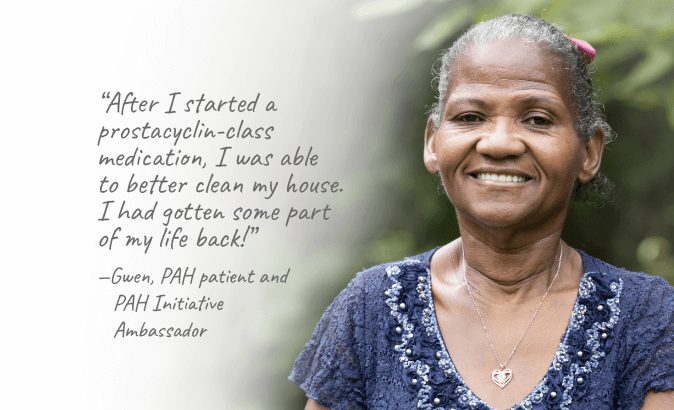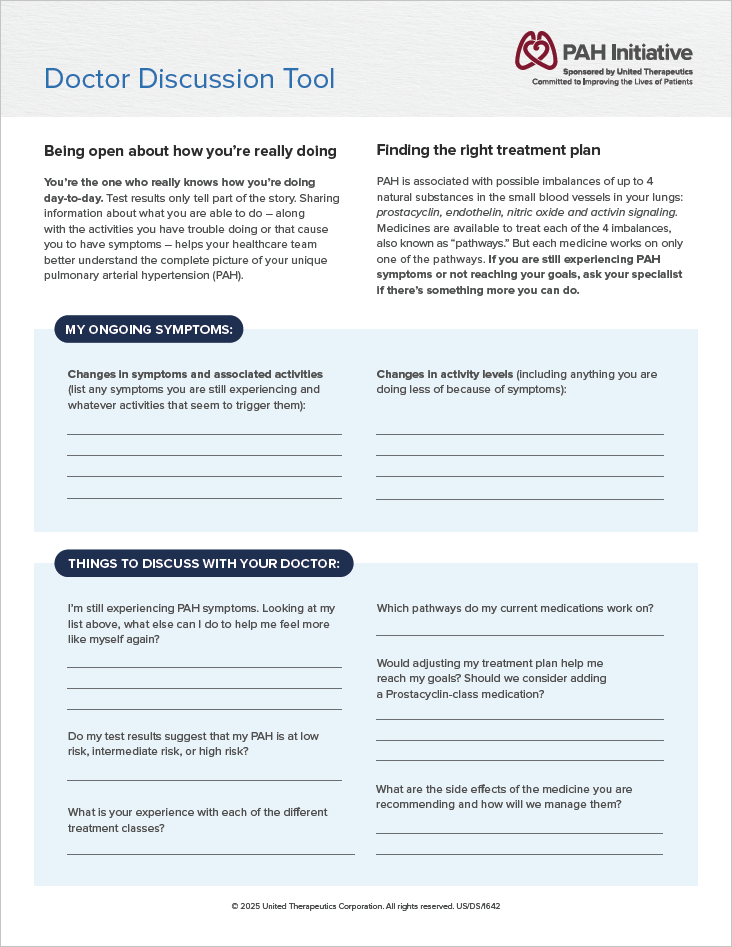What is prostacyclin?
Prostacyclin is a natural substance that is important for healthy lung function, helping keep your blood vessels open to allow normal blood flow. Unfortunately, people living with pulmonary arterial hypertension (PAH) may not produce enough prostacyclin.
Prostacyclin-class medications replace the natural prostacyclin that may be missing in people with PAH.

How do prostacyclin-class medications help patients with PAH?
Although results differ based on the specific prostacyclin-class medication used, various studies have shown that these medications may help:

Improve distance in the 6-minute walk test1,2

Keep your PAH from getting worse (slow disease progression)2
Reduce the strain on your heart (improve NT-proBNP/BNP numbers)2

Reduce pressure in the blood vessels in the lungs3
You do more without symptoms (improve your Functional Class)3
Improve your PAH symptoms, like shortness of breath and fatigue3
1: Inhaled forms.
2: Oral forms.
3: Infused forms (pump therapy).
What are the side effects of prostacyclin-class medications?
Prostacyclin-class medication side effects have been studied for decades and are well understood.
While they may vary from person to person, certain side effects are expected when starting a prostacyclin-class medication.
Side effects of prostacyclin-class medications may include:
- Headache
- Diarrhea
- Jaw pain
- Flushing
- Nausea
There may be different side effects depending on how you take the drug.
PAH specialists can help you manage side effects
Your PAH specialist should be familiar with side effects and can help you prepare for them. Talk with your doctor about possible side effects before you start taking a prostacyclin-class medication.
Find inspiration in John’s PAH story
After being diagnosed with PAH, John was frustrated but didn’t give up searching for the right treatment plan. After learning about the different ways to treat PAH, he and his specialist added an inhaled prostacyclin-class medication.
My entire life, I’ve always been active. My brothers and sisters and I were always outside. I never worried about my health growing up. I came to find out that I was taking my good health for granted. I first started noticing something was wrong on a family trip that we took to Colorado. I remember walking up a hill and getting real tired, more tired than everybody else around me. I just kind of chalked it up to being a longtime smoker and the high altitude. When I got back home after that trip, I’d get a little tired, but I didn’t really about it. I don’t think I wanted to worry about it. You know, maybe I was a little scared on the inside of what it might be. After just a few days, it got extremely worse. I couldn’t even manage a few steps without being exhausted. I knew there was something seriously wrong. I made several doctor’s appointments, and I ended up spending 3 and a half weeks in the hospital. That’s when I was diagnosed with pulmonary arterial hypertension, or PAH. Over the next few months, my weight dropped from 178 to under 130 pounds. I didn’t feel like I had any energy or strength. I was frustrated. Why did this happen to me? I talked to my doctor about the different ways to treat PAH. Today, those ways include the nitric oxide, endothelin, prostacyclin, and activin signaling pathways. At first, my doctor started me on oral medications. They helped for a while, but eventually they stopped working like I needed them to. My doctor added a prostacyclin-class medication and said it might be the treatment option that we’re looking for. I wanted to give it a shot. I received an inhaled device that lets me take a prostacyclin-class medication. After starting my inhaled prostacyclin treatment, I felt so much better. Once I got a couple weeks behind me with this new treatment, I started to feel like I could do the things that I needed to do. I do experience some coughing with my inhaled treatment, but I work with my doctor to manage my side effects. I started to see the improvement in my PAH, and my doctor said my risk status started improving. Throughout it all, my wife Wendy was my support. Wendy was my motivation. I just want to grow old with her, and I wasn’t going to let this disease get in that way or going to let her down. So I started going on walks. I started to own this disease. Since then, my treatment plan, including an inhaled prostacyclin-class medication, has continued to work. This has been my experience. Other people’s experience may be different. My advice for those battling PAH is just keep pushing yourself. If you can only take 10 steps today, take 11 tomorrow. This is a scary condition that can take everything from you. But with the right mindset and the right action plan, you can have a life worth living.
Forms of prostacyclin-class medications
Prostacyclin-class medications can be taken in several ways. The formulation you and your doctor choose will depend on various factors, including your risk status and disease severity, possible side effects, and how it fits into your lifestyle.
Inhaled
Oral (pill)
Infused (pump therapy)
The fastest-growing way to add a prostacyclin-class medication, inhaled forms now include small devices you can take with you. With inhaled forms, the medication is delivered by breathing it into the airways of the lungs.
When to consider adding a prostacyclin-class medication
Treatment guidelines recommend a prostacyclin-class medication:
- As part of an initial treatment plan if you are at high-risk status at diagnosis, or
- As an addition to an existing treatment plan if you don’t reach low-risk status quickly enough or are not reaching your treatment goals
Could a prostacyclin-class medication be right for you?
If you continue to experience PAH symptoms or aren’t reaching your goals, ask your PAH specialist if adding a prostacyclin-class medication may help you feel more like yourself again.
Start the conversation
Prepare to discuss your goals and treatment plan with your PAH specialist easily—download this discussion guide to help get the conversation started.
Download Discussion Guide (PDF)
